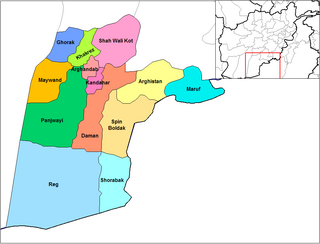
Panjwayi is a district in Kandahar Province, Afghanistan. It is located about 35 kilometres (22 mi) west of Kandahar. The district borders Helmand Province to the southwest, Maywand District to the west, Zhari District to the north, Arghandab, Kandahar and Daman districts to the east and Reg District to the south. Panjwayi was reduced in size in 2004 when Zhari District was created out of the northern part of it, on the northern side of the Arghandab River, which now forms the northern boundary.
Operation Mountain Thrust was a joint NATO and Afghan-led military operation in the War in Afghanistan. It involved more than 3,300 British troops, 2,300 U.S. troops, 2,200 Canadian troops, along with approximately 3,500 Afghan soldiers, supported by extensive air power. Its primary objective was to quell the ongoing Taliban insurgency in the south of the country.

Sangin is a town in Helmand province of Afghanistan, with a population of approximately 20,000 people. It is located on 32°4′24″N64°50′2″E in the valley of the Helmand River at 888 m (2,913 ft) altitude, 95 km (59 mi) to the north-east of Lashkargah. Sangin is notorious as one of the central locations of the opium trade in the south of the country, and is also a town that has traditionally supported the Taliban. It was described by British newspaper The Guardian as "the deadliest area in Afghanistan" in 2010. Sangin also houses the main bazaar for Sangin District. Route 611 passes through Sangin.

Operation Medusa was a Canadian-led offensive during the second Battle of Panjwaii of the War in Afghanistan. The operation was fought primarily by the 1st Battalion, The Royal Canadian Regiment Battle Group and other elements of the International Security Assistance Force, including A Co, 2-4 Infantry BN, 4th BDE, 10th Mtn Division, supported by the Afghan National Army and a team from the United States Army's 1st Battalion, 3rd Special Forces Group (Airborne) augmented by C Company, 2nd Battalion, 87th Infantry Regiment of the 10th Mountain Division. Its goal was to establish government control over an area of Kandahar Province centered in the district of Panjwayi some 30 kilometres (19 mi) west of Kandahar city. A tactical victory, it resulted in the deaths of 12 Canadian soldiers; five during the major combat operations, five in bombings, and two in a mortar/RPG attack during the reconstruction phase of the operation. Fourteen British military personnel were also killed when their plane crashed. Despite suffering a brutal battlefield defeat, the Taliban retained their presence in Kandahar province and did not lose their will to fight, leading to the subsequent Operation Falcon Summit. Nonetheless, Operation Medusa was at the time the most significant land battle ever undertaken by NATO.

Operation Mountain Fury was a NATO-led operation begun on September 16, 2006 as a follow-up operation to Operation Medusa, to clear Taliban insurgents from the eastern provinces of Afghanistan. Another focus of the operation was to enable reconstruction projects such as schools, health-care facilities, and courthouses to take place in the targeted provinces.

Operation Herrick was the codename under which all British operations in the War in Afghanistan were conducted from 2002 to the end of combat operations in 2014. It consisted of the British contribution to the NATO-led International Security Assistance Force (ISAF), and support to the American-led Operation Enduring Freedom (OEF), within the South Asian country.

Operation Falcon Summit was a Canadian-led operation in the Battle of Panjwaii and, on a larger scale, in the War in Afghanistan.

In January 2006, NATO's focus in southern Afghanistan was to form Provincial Reconstruction Teams with the British leading in Helmand Province and the Netherlands, Australia and Canada leading similar deployments in Orūzgān Province and Kandahar Province respectively. The United States, with 2,200 troops, stayed in control of Zabul Province. Local Taliban figures voiced opposition to the incoming force and pledged to resist it.

The following items form a partial timeline of the War in Afghanistan. For events prior to October 7, 2001, see 2001 in Afghanistan.

The Helmand province campaign was a series of military operations conducted by the International Security Assistance Force (ISAF) forces against Taliban insurgents and other local groups in the Helmand Province of Afghanistan. Their objective was to control a province that was known to be a Taliban stronghold, and a center of opium production. None of the ISAF's intended strategic and political objectives were achieved in the long term.
The Battle of Musa Qala was a British-led military action in Helmand Province, southern Afghanistan, launched by the Afghan National Army and the International Security Assistance Force (ISAF) against the Taliban on 7 December 2007. After three days of intense fighting, the Taliban retreated into the mountains on 10 December. Musa Qala was officially reported captured on 12 December, with Afghan Army troops pushing into the town centre.

US and NATO International Security Assistance Force (ISAF) operations, alongside Afghan National Army forces, continued against the Taliban through 2007.
The following lists events that happened during 2006 in Afghanistan.
Events from the year 2010 in Afghanistan.
The following lists events that happened during 2016 in Afghanistan.
Events in the year 2017 in Afghanistan.
The town of Sangin, in Helmand Province, Afghanistan, was captured by the Taliban on 23 March 2017. For two months, the Taliban had launched fresh attacks in trying to recapture the town.
This article summarizes the history of the War in Afghanistan (2001–2021).
The 2006 Taliban offensive was a major military offensive launched by the Taliban in southern Afghanistan in the spring of 2006. The offensive was planned to unfold on three main fronts concentrated in the provinces of Helmand and Kandahar: the first front was to target northern Helmand, focusing on the districts of Sangin, Nowzad, and Kajaki. The second front aimed at southern Helmand, with a focus on the districts of Garmser and Nawa. The third, and most important, would be western Kandahar, targeting the districts of Maiwand, Zharey, and Panjwayi.










